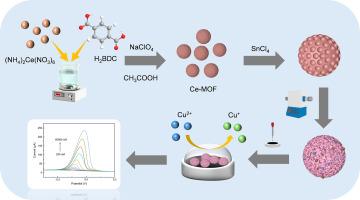Bimetallic MOF-derived hierarchical porous carbon spheres for electrochemical Cu2+ sensing
IF 4.9
2区 化学
Q1 CHEMISTRY, ANALYTICAL
引用次数: 0
Abstract
The development of detection devices with rapid response, high sensitivity, and precise detection capabilities for heavy metal ions remains a research hotspot in environmental protection and food safety. In this study, a facile and efficient synchronous doping/etching strategy was employed to synthesize hierarchically porous bimetallic MOF-derived CeSn@C-10 material. Comprehensive characterization techniques, including X-ray diffraction (XRD), X-ray photoelectron spectroscopy (XPS), scanning electron microscopy (SEM), and transmission electron microscopy (TEM) revealed that the incorporation of Sn species significantly enhanced oxygen vacancy concentration in the CeO2 lattice while stabilizing low-valent Ce3+ species, thereby boosting the electrocatalytic activity for CeSn@C-10. The hierarchical porous architecture endowed the material with an enlarged specific surface area and improved accessibility to active sites. When fabricated into an electrochemical sensor (CeSn@C-10/GCE), it exhibited exceptional Cu2+ detection performance with dual linear ranges of 0.2–5 μM and 5–60 μM, achieving a low detection limit of 38 nM (S/N = 3). The sensor demonstrated remarkable anti-interference capability and promising applicability in real-sample analysis. This work provides a novel strategy for designing hierarchically porous bimetallic electrochemical sensors through synergistic enhancement mechanisms.

电化学感应Cu2+的双金属mof衍生的分层多孔碳球
开发对重金属离子具有快速响应、高灵敏度、精确检测能力的检测设备一直是环境保护和食品安全领域的研究热点。在这项研究中,采用一种简单高效的同步掺杂/蚀刻策略来合成分层多孔双金属mof衍生的CeSn@C-10材料。x射线衍射(XRD)、x射线光电子能谱(XPS)、扫描电镜(SEM)和透射电镜(TEM)等综合表征技术表明,Sn的加入显著提高了CeO2晶格中的氧空位浓度,同时稳定了低价Ce3+,从而提高了CeSn@C-10的电催化活性。分层多孔结构赋予材料更大的比表面积和更佳的活性位点可达性。制备成电化学传感器(CeSn@C-10/GCE)后,在0.2 ~ 5 μM和5 ~ 60 μM的双线性范围内表现出优异的Cu2+检测性能,检测限低至38 nM (S/N = 3)。该传感器具有良好的抗干扰能力,在实际样品分析中具有广阔的应用前景。这项工作为通过协同增强机制设计分层多孔双金属电化学传感器提供了一种新的策略。
本文章由计算机程序翻译,如有差异,请以英文原文为准。
求助全文
约1分钟内获得全文
求助全文
来源期刊

Microchemical Journal
化学-分析化学
CiteScore
8.70
自引率
8.30%
发文量
1131
审稿时长
1.9 months
期刊介绍:
The Microchemical Journal is a peer reviewed journal devoted to all aspects and phases of analytical chemistry and chemical analysis. The Microchemical Journal publishes articles which are at the forefront of modern analytical chemistry and cover innovations in the techniques to the finest possible limits. This includes fundamental aspects, instrumentation, new developments, innovative and novel methods and applications including environmental and clinical field.
Traditional classical analytical methods such as spectrophotometry and titrimetry as well as established instrumentation methods such as flame and graphite furnace atomic absorption spectrometry, gas chromatography, and modified glassy or carbon electrode electrochemical methods will be considered, provided they show significant improvements and novelty compared to the established methods.
 求助内容:
求助内容: 应助结果提醒方式:
应助结果提醒方式:


